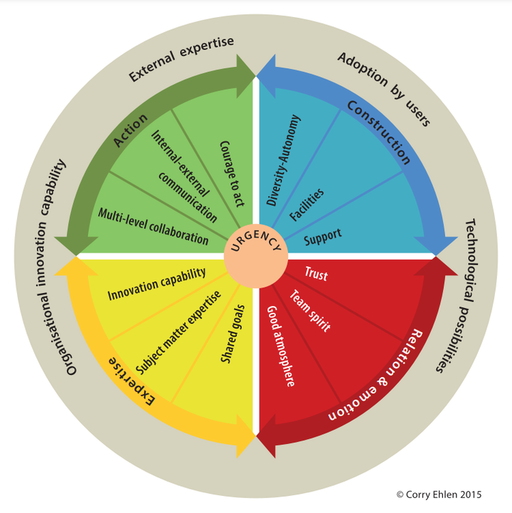Realising added value - overview per group of stakeholders
In co-creation processes, the partners pursue added value for all the parties involved and added value for the partnership as a whole. An overview per group of stakeholders:
PROFESSIONAL FIELD
Education geared to the professional field
- Future-proof curriculum
- Involvement and participation
- Graduates are fully qualified, are more readily employable, and command the “right” competencies
Forum for campus recruitment:
- Inspiring students at an early stage
- Employer branding and reputation management supported by the higher education establishment/programme
The results constitute actual (added) value for the professional field:
- Opportunity to utilise the expertise of students, teachers, and researchers to find solutions to issues that businesses cannot resolve on their own
- Students carry out assignments (free of charge)
- Enrichment through fresh and creative ideas
- Time for innovation that is not always available in organisations
Professional development:
- The opportunity to become more proficient in co-creation
- Lifelong learning: the programme opens up opportunities for in-service staff training
- Staff reflect on their own actions
- Broadening horizons through the exchange of knowledge and skills
- Exchange and informal learning
Network expansion
Sustainable partnerships with the programme and possibly other partners
Realising a sustainable impact
Combining various forms of expertise
STUDENTS
High-quality learning environment
- Up-to-date curriculum
- Receiving feedback from teachers and the professional field
- More opportunities for learning through close collaboration in the professional field
Student motivation
- Immediate application in a business renders students aware of the necessity of what they have learned: this intensifies the learning process
- Ownership: an authentic situation encourages students to achieve their goal
- Higher study efficiency and more intensive learning process
Development of competencies by students
- Co-creation skills
Future-oriented approach
- Enabling students to acquire co-creation competencies that are important in the current and future labour markets and in society (VUCA)
- Preparation for the labour market; job opportunities
- Possibility to expand networks
- Well informed choice of career
Opportunity to connect education and research
HIGHER EDUCATION INSTITUTION
Mapping and focusing the framework for authentic education
Collective frame of reference/common language
PROGRAMME
Quality of the programme
- Opportunity to keep the programme up to date
- Continuously keeping a finger on the pulse
- Up-to-date course material and lesson content, featuring practice-oriented cases
- Cross-pollination in the programme
- Insights often find their way back to the programmes
- Workplace know-how as a source of authentic education
Professional orientation of the programme
- Interaction between the professional field and the programme
- Programme focus is geared to the professional field
- Curriculum is geared to the requirements of the professional field; also: checking how this impacts on working formats and evaluation formats
- Expectations and requirements of the professional field, in terms of additional or changing competencies of graduates, are becoming clear
- Testing daily operations for compatibility with the professional field
Student competencies
- Adequate feedback enables students to acquire the competencies
- Enabling students to acquire co-creation competencies that are important in the current and future labour markets and in society (VUCA)
- Proper emphasis on soft skills within the programme
- Utilising the developed tool to identify opportunities for co-creation within the lesson assignment
Developed instruments can be utilised in multiple projects
Professional development of lecturers
Network expansion
Achieving societal impact as a programme
Opportunity to connect education and research: integrating aspects of research and education into co-creation processes
Added value in terms of PR
RESEARCHERS
Professional development
- Co-creative research technology and methodology
- Innovation through multi-disciplinary collaboration and complementarity of the partners
Increasing impact of research
- Enhancing opportunities for implementing innovations
- Immediately verifying added value of research results
- Achieving a sustainable impact
Network expansion and reinforcement
- Increasing involvement of the professional field in research
- Expanding the organisational network required for the valorisation of the research results
Substantive insights generated by the research
Opportunity to conduct research: impact of methodology and approach
CO-CREATION
HOW?
TOPIC 2
Factors that guarantee innovative and successful co-creation
The Co-creation Wheel presents the co-creation success factors in a scientifically validated manner. The Co-creation Wheel is a diagram displaying four dimensions, twelve mechanisms, and five factors that promote innovation success (Ehlen C. , van der Klink, Stoffers, & Boshuizen, 2017).

The wheel can be used as a tool to monitor the development of a co-creation-project.
